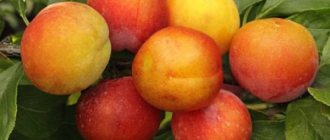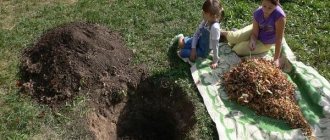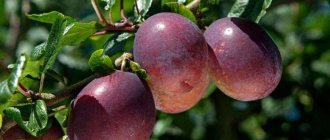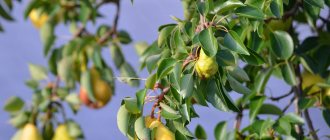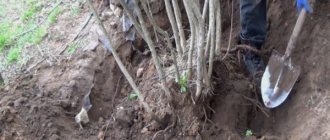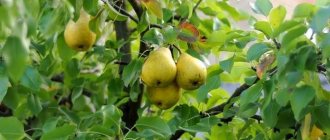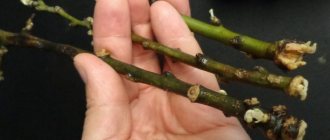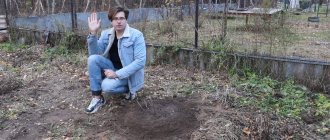Why do you need to replant fruit trees?
Plants are rarely transplanted to a new location. Experts recommend planting pear trees immediately in a permanent plot, since such a procedure is very stressful for young trees.
There are several main reasons when carrying pears is required:
- unfavorable conditions for germination;
- transfer of grown plants due to site redevelopment or relocation;
- purchasing a seedling from a nursery.
Experts recommend planting pears immediately on a permanent plot.
If the initial location for the pear was chosen incorrectly, the tree will develop, bloom, and bear fruit poorly. In such cases, a transplant will be justified.
How to plant a pear: video
In any regions where the climate allows for growing pears, they are planted the same way. Having chosen a place and neighbors for the pear, they prepare a planting hole.
In any region where the climate allows for growing pears, they are planted the same way.
If the seedling is going to be planted in the fall, then the hole is prepared in the spring or summer, but not later than 3 weeks before planting. For spring planting, the place for the seedling is prepared the previous fall. They prepare the place for spring and autumn planting of pears in the same way, only they do it in different seasons. The pit is made with a diameter of 70 cm and a depth of 1 m.
Dimensions of the pit for planting pears
The top, fertile layer of soil is laid in one direction, the rest of the soil in the other. If the site has sandy loam soil, then a layer of clay at least 10 cm thick is placed at the bottom of the hole to retain moisture at the roots. On heavier soils there is no need to do this. Then compost or humus is poured into the hole. The thickness of this layer is 20 cm. The fertile soil deposited earlier is mixed with mineral fertilizers. Nitrophoska 100 g or 60 g of superphosphate and 30 g of potassium salt are added to the soil. This mixture is returned to the pit. The top is covered with infertile soil, a stake is driven in so that it rises at least 75 cm above the ground and left until planting. If the soil on the site is very heavy, then add two buckets of coarse sand to the infertile soil.
The support for the pear seedling is driven into the center of the planting hole.
When the time comes to plant a pear, the soil in the prepared hole is raked so that a mound is formed in the middle, and the width of the depression allows the roots of the seedling to be placed without bends.
Scheme of planting a pear seedling
The seedling is lowered into the hole, the roots are straightened and covered with earth. The root collar should protrude 3–5 cm from the ground.
The root neck of the pear seedling should protrude 3–5 cm from the ground
If the seedling is grafted, then the grafting site, with this placement of the seedling, turns out to be 10 - 15 cm above ground level.
The grafting site should be 10-15 cm above ground level
Only dwarf pears that are grafted onto quince are placed so that the soil covers the grafting site. Quince is a southern plant and by burying the part of the seedling that remains from it into the ground, they protect the entire seedling from freezing.
Having filled the hole to the top, the earth is compacted.
Having filled the hole to the top, the earth is compacted
An earthen roller is formed along the edge of the planting hole. And water it with two buckets of cold water.
Water a pear seedling with cold water
The planted tree is tied to a peg installed on the north side of the pear in two places so that its trunk grows vertically.
I tie up a pear seedling in two places
After the water is absorbed, the tree trunk circle is mulched - covered with a 5–6 cm layer of peat, humus, sawdust or straw.
After watering, mulch the trunk circle of the pear seedling
When is the best time to buy seedlings?
Less experienced gardeners prefer to plant fruit trees in the spring, although in the fall there is a larger selection of seedlings and these trees are more viable.
In nurseries, seedlings for sale with an open root system are dug up in the fall. In the spring you can purchase seedlings that were not sold last year. On farms that grow planting material, there are many such trees and it is difficult to pay attention to each one. If a summer resident purchases seedlings in the fall, it is much easier for him to preserve several trees without damage until spring.
Pears purchased in the fall for spring planting are quite easy to store. To do this, they are buried in the area where they plan to grow them next year. Unnecessary excavation work can be avoided if you use a hole to store the seedling, prepared for planting a pear, but not yet covered with prepared soil. The northern wall of this pit should be made vertical, and the southern wall inclined by 30–45°.
Recent Entries
Lilac perennials that are beautiful, compact and do not crowd out other plants Why when buying seedlings you should not take the sellers’ word for it and how to determine the age of the plant using 3 signs Tomato seedlings have turned purple or whitish: why the color has changed and how to save the plants
Scheme of laying a pear seedling in a trench
Before placing the seedlings in the trap, they are soaked in water for 5–6 hours. No stimulants or fertilizers are added to the water. The roots of trees taken out of the water are inspected and any damaged ones are removed. Place the seedling on an inclined wall so that the roots face north and the branches are above ground level. The roots are sprinkled with a 20 cm layer of prepared soil. They try to leave as few voids as possible in the soil covering the roots. Water and, after the water has been absorbed, sprinkle with a layer of dry soil 5–6 cm. Until the first frost, nothing else is done. When the air temperature at night drops below 0°, the pit is completely filled up. A small mound above it will divert some of the melt water from the pit.
The branches of the seedling protruding from the ground are lined with cuttings of raspberries or other thorny plants to protect them from rodents. It is forbidden to cover the trench with any covering material. It’s better to add snow there several times during the winter. Under the insulation, the plant will wake up before it can be planted. Preserved in this way, seedlings take root well in the spring and grow quickly.
Timing for transplanting pears to a new location
By the time of transplantation, the pear should have completely finished bearing fruit. But at the same time, the tree should have time to adapt and take root. It only takes 1-1.5 months for young seedlings to take root and survive the winter normally. In mature trees, the adaptation period is at least 2 months.
Depending on the variety, the optimal planting period is September-October.
Also, the time of transplantation depends on the region in which the pear grows, since the period when sap flow stops occurs at different times.
The dates when you can replant a pear also depend on the location of germination:
- in the southern regions, work is carried out from October to November;
- in the northern regions, planting is completed by the 10th of October;
- in the central part of the country, transplants are carried out from mid-September to mid-October.
The exact dates are determined depending on the specific climate of the area, as well as the weather characteristics of the current season.
Preparation
You must first dig a hole. The pit is prepared a month before the transfer.
Construction of a landing pit.
The depth of the planting recess must be at least 90 cm . In this case, the width should be from sixty to one hundred and twenty centimeters - this depends on the age and size of the pear. A drainage mixture is introduced to the bottom - crushed stone, broken brick . This will prevent waterlogging due to stagnation of water, especially if there have been heavy rains for a long time or groundwater is located nearby.
Broken red brick, rubble stone or crushed stone are suitable as drainage.
The next layer in the pit should consist of organic fertilizers in combination with superphosphates, which are mixed with the soil . If the soil is acidic, neutralize it by liming. If three-year-old trees are transplanted, they can be dug up like regular young trees for planting, exposing the root system. The day before the event, the seedling is placed in a bucket of water.
Advantages of autumn pear transplantation
Planting seedlings and replanting young trees can be done with equal success both in spring and in autumn. Each period has its own characteristics.
The main advantages of replanting trees in autumn:
- transplanted plants do not need to spend energy on the growth and development of a green crown; all their nutrients will be used for rooting;
- plants that have been transplanted in the fall are more resistant to frost and any bad weather;
- no need to worry about watering (moisturize only when planting, and then the tree will have enough moisture from natural precipitation).
Recommendations
The pear begins to bloom and bear fruit 4–7 years after planting; a lot depends on the variety and agricultural technology.
In order for the transplanted plant to develop comfortably, experienced gardeners use agrotechnical tricks.
It is not recommended to plant a tree in shaded areas, since in this case, the active phase may not occur, and the new plant will wither over time . But you should also avoid places where there is strong wind or drafts - flower stalks and the first fruit ovaries will be torn off.
It is not recommended to use clay or marshy soils for planting - they will retain moisture, and waterlogging contributes to the development of diseases. And it is also prohibited to plant a tree in an area where rowan grows nearby. Both species suffer from similar diseases, which is detrimental to the novosad. You cannot replant a pear during the flowering period.
How old should a tree be?
Pears do not like frequent transfers from place to place. The younger the plant, the easier and faster it adapts to a new place.
If the seedling has just been planted, and there is already a need to move it to a new place, you should not do this. The young plant is given a little time to get used to and gain strength to undergo another transplant.
Transplanting young, newly planted seedlings should be done as a last resort, since in 60% of cases they die. And if they take root, they lose their taste and other parental characteristics.
Care after transplant
Upon completion of the work, make a solution from any growth-stimulating drug - “Kornevin”, “Epin”, “Zircon”, “Kornerosta” . Diluted according to instructions. A seedling will need 10 liters, a young one - 20 liters, an adult - 30 liters. Water evenly, covering the entire circle around the trunk.
To maintain aeration and soil moisture for a long time, the tree trunk circle is mulched with peat, humus, sawdust, and wood chips. Water periodically. Do not allow the soil around the tree to dry out or become waterlogged.
Is it possible to replant an adult pear tree?
Experts do not recommend replanting adult pears from place to place. Plants that are 3 years old will best tolerate the procedure. Older pears are tolerated as a last resort and with extreme caution.
Since columnar pears have a shallow and less developed root system, they tolerate transplantation to another location more easily and adapt more quickly.
Plants aged 5 to 10 years will be able to adapt to a new location and continue to bear fruit. But before transplanting, you need to make sure that they have no signs of disease or the presence of pests.
Trees older than 10 years have a highly developed root system; when replanting, the roots are damaged. Such pears are very difficult and rarely take root and are restored.
Requirements for the transplant site and planting material
Since the pear is very thermophilic, you need to choose a place for it based on its needs. The crown of the tree should receive enough light - this will ensure a normal level of photosynthesis and increase productivity. Pears also love space and solitude, so they are placed no closer than 5 meters from buildings and other trees. The place should be without blowing winds, preferably on the south or southeast side. The proximity of groundwater to the roots is also important, since constant washing away leads to rotting and fungal attack: the distance should be at least 3 meters. As for the soil, you need to pay attention to acidity and nutritional value. Heavy and infertile soil will be depleted by the tree in literally three years, and then it is no longer advisable to replant it. Loamy or sandy soil with a fertile layer of about 25 cm is optimal. The maximum acidity should be no more than 6.5. If it is higher, then lime is added to the soil. The success of growing a pear orchard depends largely on the initial condition of the seedlings.
Important! Pears need cross-pollination, so it is better to have several of them in one area - the chances of getting a good harvest will be higher.
If you are replanting a tree from a nursery or from a neighbor’s garden, then pay attention to the following nuances:
- development of the root system. The tree should have several main roots that are externally healthy and without signs of disease, and many small ones. If there are blackened roots or they resemble a washcloth, then nothing good will grow from such material;
- the older the tree, the worse it tolerates transplantation;
- The trunk should be even, with a beautiful, smooth bark, without damage. The branches of the tree should also be smooth and elastic.
The better the pear looks, the greater the likelihood of survival after transplantation.
Mistakes when transplanting pears
Gardeners rarely have to replant mature trees. Very often, due to inexperience, various mistakes are made that lead to poor adaptation of the tree or its death:
- Insufficient or excessive depth. Gardeners often ignore the fact that the soil will gradually settle under the weight of the tree.
- Improper preparation of the planting hole. When preparing the hole, take into account the size of the root system.
- The soil is too acidic. With high acidity, the pear will not take root well. In this case, you must first add lime, dolomite flour and wood ash to it.
- Incorrect watering. The water is distributed in a circle, and not directed to the very center. Excessive or insufficient watering is equally harmful to pears. If there is a lack of moisture, the plant will not adapt well; if there is a large amount of moisture, there is a high probability of root rotting.
- Wrong choice of landing site.
- Too much root pruning. When replanting, they try to trim the roots as little as possible.
- Early fruiting. The first year after planting, all ovaries are removed, allowing the plant to spend all its energy and nutrients on developing the root system.
When replanting, try to trim the roots as little as possible.
Each cut is treated with charcoal to prevent various dangerous infections from entering the plant.
Selecting a location
Once the farmer has decided to replant the pear tree, the question of choosing a location arises. This point should be treated very scrupulously, since if you choose an unsuccessful place for re-transfer, the tree will not be able to withstand it and will inevitably die.
An area open to the sun with low groundwater is suitable for pears.
It is worth considering that replanting is already stressful for the plant, and double stress can lead to death. In addition, a number of conventions should be taken into account for the easiest adaptation:
- occurrence of groundwater;
- presence of buildings;
- access to light;
- levelness of the place;
- neighborhood of similar varieties.
If there is groundwater in the area close to the surface of the earth, you should choose another place for planting . As a last resort, it is allowed to pour earth onto the intended location.
The place should be level, without potholes or hills . In addition, it is advisable not to plant an adult tree in places of increased crowding, that is, there should be no buildings, barriers or other structures nearby. The maximum distance is five meters. It is recommended to avoid places with high humidity. To ensure cross-pollination, similar varieties of pears can be planted nearby; several different similar species are recommended.
Characteristics of culture
All modern varieties are bred from the common (forest) pear, which can grow up to 25 m in height. If the apple tree can produce crops inconsistently, then the pear tree produces a bountiful harvest every year. But this, of course, is the prerogative of new varieties adapted to local growing conditions.
The most popular varieties:
- from the early ones - Thumbelina, Lada, Vidnaya;
- middle ones - Chizhovskaya, Botanicheskaya, Velesa;
- late - Bere winter Michurina, Belorusskaya late.
Many varieties are capable of regulating fruiting themselves: this year some branches produce a harvest, others rest; next season it will be the other way around. Due to this property, there is no periodicity of fruiting.
Veles pear
Important! These advantages appear only when the pear is planted in a long-lit place, the crown is formed correctly, and careful care is taken.
